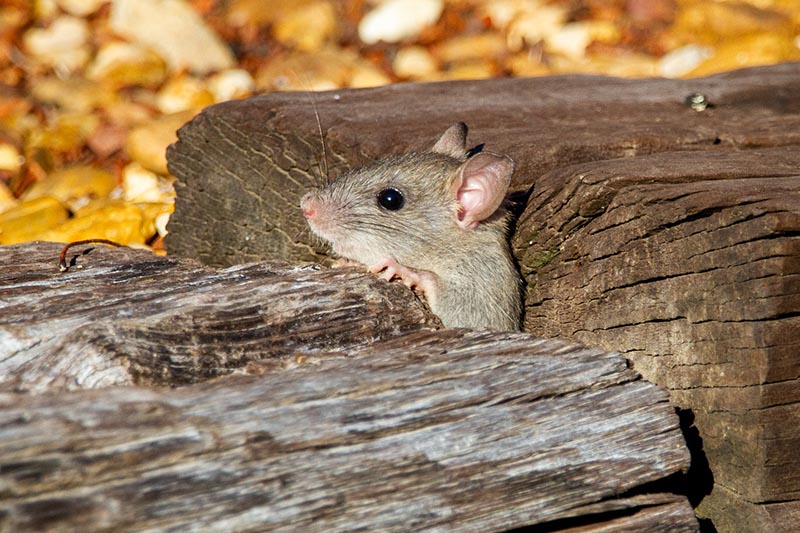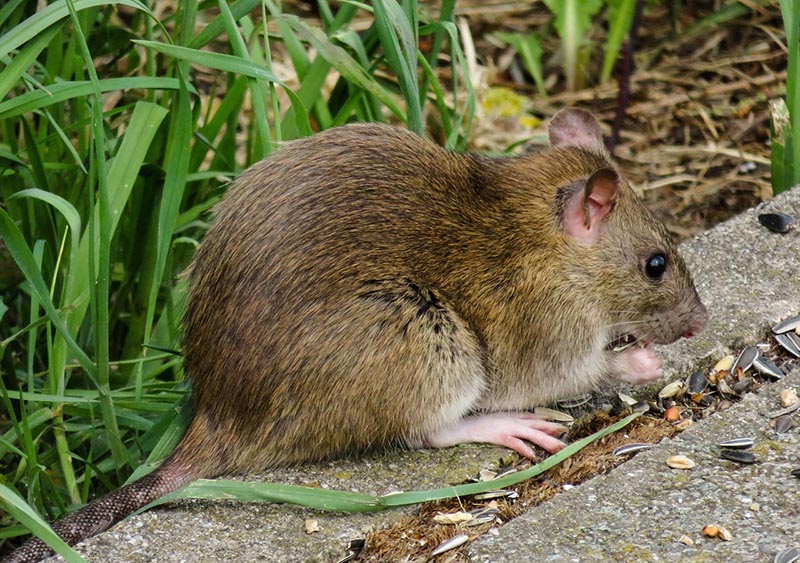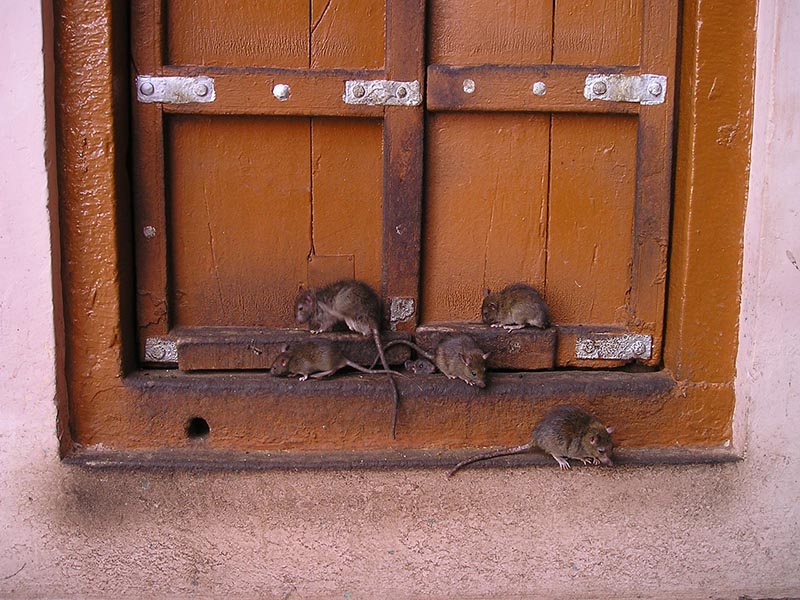Rats in Missouri: Types, Facts, & Tips for Homeowners
-
Pete Ortiz
- Last updated:

If you live in Missouri, there’s a chance you’ve encountered a rat at some point, especially if you live in an urban area. These rodents don’t just live under bridges and in sewers – they thrive in almost any environment that’s even slightly hospitable to them.
They love living close to humans because it gives them easy access to readily available food like potato sacks, peanut shells from factories, and discarded apple cores from orchards. Let’s discuss some of the most common types of rats that you may find in the state.
The 4 Types Of Rats In Missouri
1. Brown Rat

- Color: Brownish gray
- Length (head to tail): 16 inches
Also sometimes referred to as the “Norway Rat“, this is the type of rat that dwells in sewers and subsists on scurrying between the cracks in city streets. It can grow to be up to 16 inches long, including its tail, and can weigh up to half a pound. These rats can be brown or black in color, though brown rats are much more common.
2. Roof or Feral Rat

- Color: Gray
- Length (head to tail): 11 inches
The roof rat is another common type of rat found in Missouri. It has a similar appearance to the black rat and is also about 16 inches long, including its tail, and weighs about a half pound. It’s known for being bold, cunning, and extremely destructive. It’s very common in urban and suburban areas throughout the state. The roof rat is so named because it prefers to live in the upper levels of structures such as barns, sheds, and rafters of buildings. It’s also known as a “feral” rat because it’s believed to have originated in domestication but has reverted to more wildlife-type behavior over time.
3. House Mouse

- Color: Grayish-brown, white bellies in some cases
- Length (head to tail): 2.5-3.75 inches
The house mouse is also found in Missouri, but it’s not nearly as large or destructive as the other types of rats. House mice are very small, only growing to be about 2 inches long, including their tails. They weigh between one and four ounces, making them the smallest of all the types of rats in Missouri.
The house mouse is typically light brown or gray in color, but some may have white bellies. House mice are found primarily indoors, where they can take advantage of human food and shelter. These rats are not typically considered pests in rural areas, but they do cause significant damage to indoor areas where food and shelter are readily available.
4. Yellow-Bellied Marmot or Chamma
- Color: Brown, tan, and gray
- Length (head to tail): 16 inches
The yellow-bellied marmot or chamma is a wild rodent that lives in the mountains of Missouri. Although it’s found in mostly rural areas, it also sometimes makes its way into towns and villages. It’s sometimes mistaken for a squirrel, but it’s actually a type of marmot. Like most marmots, it’s a burrowing rodent and digs large, complex tunnel networks. The yellow-bellied marmot is actually the largest species of marmot in the United States, weighing up to two pounds. It has very soft fur and is a yellowish-brown color, with a white belly.
The 7 Ways to Keep Rats Away from Your Home
Rats are sneaky, resourceful creatures. They’ll take advantage of any opportunity to take up residence in your home, no matter how well-prepared you think it is. That’s because rats are expert climbers with sensitive whiskers that help them feel out potential structures for nesting. Hunting rats is challenging work but keeping them away from your home is easy if you know their tricks and habits.
Rats prefer dark, hidden spaces where they can nest and feed on food scraps from local businesses. If you can keep their hiding spots to a minimum and remove all sources of food they may be attracted to, you’ll keep them at bay.
1. Make Sure You’re Not Attracting Rats

If you want to keep rats away from your home, you need to make sure that you aren’t a hospitable host. This means keeping your property clean and free of food scraps and any other signs of a potential source of food. You’ll need to be especially diligent about keeping your property clean if you live near a restaurant or other commercial building that may be providing food scraps for rats.
Rats have a highly developed sense of smell, so keeping everything clean and free of odors will help keep them at bay. Make sure to keep your property’s outside clean, too. Cut back any overgrown vegetation near your home, and make sure there aren’t any food scraps lying around outside.
2. Seal Up Any Holes or Cracks in Your Home
Rats can squeeze through openings as small as a dime, so make sure to check inside and outside your home for any cracks or holes. Repair any gaps you find with caulk or whatever works best in your situation.
These nocturnal scavengers can also chew through wood, so take care to make sure your home has no weak spots. If you’re worried about rats gnawing their way into your home through a wall, you can purchase soundproofing materials to keep them out. Rats are also excellent climbers, so make sure to seal any potential entry points at ground level as well.
3. Install Rat-Proof Fencing and Gates

If you live near a garden or other outdoor space where rodents might tend to gather, you can keep them out with proper fencing. A fence between 4 and 6 feet high is typically enough to keep rats out of a garden, but you should always check your local building codes to make sure. You can also prevent rats from accessing the property with the right kind of gate. Consider a gate with a mesh-like grid no larger than 1 inch, or rodents can squeeze right through.
4. Use Traps and Rodenticides Wisely
Traps are a great way to reduce the number of rats in your property. Make sure to buy the right kind for the specific species of rat in your area and use an expert-approved trap placement to avoid catching other animals or children. Always remember to use traps responsibly.
Never leave a trap out when there are pets or children in the house, and make sure to check traps daily to avoid any accidental injuries. You can’t use traps for outdoor pests, so if you need to get rid of rats in a garden or other outdoor space, you’ll need to use rodenticides. Always follow the instructions on the packaging and label, making sure to keep the poison out of reach of children and pets.
5. Get a Dog

While this isn’t always practical, a well-trained dog can be an excellent addition to any household. While this isn’t always practical, a well-trained dog can be an excellent addition to any household. Dogs are naturally curious, so they might sniff out a rat infestation and begin barking. This can help you catch the problem early and prevent it from becoming serious.
Dogs can also kill rats if you find yourself with an infestation you can’t handle on your own. Be careful, though. Never leave a dog unattended with a rat or any other animal. While dogs are excellent for outdoor pests, a cat may be a better choice for indoor rats. Cats are natural hunters and can easily keep a rat infestation under control, provided they have enough room to roam. However, cats aren’t always the best solution for outdoor pests.
6. Try Electronic Repellents
Electronic repellents use lights and noises to drive pests away from your home. This isn’t a permanent solution, but it’s a good option for a quick fix while you’re on vacation or until you can get a more permanent solution in place.
Electronic repellents that emit lights and sound can be effective at driving rats away. However, different pests respond to different frequencies, so you’ll want to make sure the device you choose is designed to repel the type of rats in your area. Some repellents are designed to repel rats and mice, while others are designed to repel rats only.
7. Rotate Chemical Repellents and Odors

Rats are highly intelligent and adaptable, so chemical repellents won’t be a permanent solution. However, if you rotate chemical odors and scents, you can keep rats away for a few days or a week at a time. This may not sound like much, but it can be enough to give you time to repair any issues that may be attracting rats or get any other long-term solutions in place.
Rats are very sensitive to scents, so you have lots of options for rotating various odors. You can try using ammonia, citrus, peppermint, or any number of scents that rats don’t like. You can also use products designed to deter rats, such as liquid peppermint, mint oil, or even vanilla extract.
Conclusion
There are only a few different rat species that you will find hanging around the state of Missouri. This is likely due to the state’s moderate weather and open terrain. Though some rats may be more common in urban areas, these nocturnal creatures can also be seen and forest preserves and other wooded areas.
Almost every space with shelter and food sources will attract rats, but some areas have a significantly higher rat population than others. There are many different types of rats in Missouri, but the most common type is the brown rat, also sometimes called the Norway rat.
Featured Image Credit: Joshua J. Cotten, Unsplash
Contents



